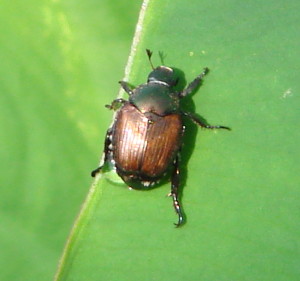Hello, fellow readers, Caught in the act! I found the culprit of Carolyn’s holy rose dilemma we spoke about last week. As I arrived with Pyrethrin in hand, there they were, the shiny green and rust-colored beetles chomping away. Yes, indeed, it’s Japanese beetle time.
Their arrival brings a memory of how Mom hired her five-pack to collect the suckers— five cents a Jiffy jar full. How fun! It was her strategy of killing them that was a bit grim. She’d boil up a pot of water and toss them in. None of us had the courage. Nor have I ever tossed a live lobster into boiling water. Poor things.
Why Japanese Beetle Control Requires a Two-Punch Strategy
Japanese beetles (Popillia japonica) are a nuisance even before they become good-looking iridescent beetles. Their crescent-shaped grayish-white larvae, called grubs, live in the soil and feed on the roots of grasses and plants. If there’s a dead area of grass that you can easily lift, you will probably find Japanese beetle grubs as the culprit. On top of that, critters love grubs and rip up the turf to feed on them.
They were first found in New Jersey in 1916 and are now in every state in the eastern U.S. except Florida. The invasive critters continue to move west.
Adult beetles emerge in late June, feed and mate into September, and then lay their eggs back in the soil. Thus, controlling them requires a two-part strategy: one for the grubs and one for the beetles.
Punch-One: Pyrethrin
A few hours after spraying Carolyn’s roses with Bonine Pyrethrin Garden Spray, I sent an email assuring redemption is underway that went like this:
It was fascinating to see how Pyrethrin, derived from chrysanthemum flowers, kills the suckers almost on contact (photo evidence attached). I’ve read about the instant impact on insects’ nervous systems but never witnessed it. I felt a tad bad for the beetles. And a bit triumphant, too. What a holy mess they’re making of your roses!
Roses are one of their favorite feasts, along with about 300 other plants, such as fruit trees, berries, and vegetable plants. In their feeding frenzy, which lasts four to six weeks, they’ll do a lot of damage. Some folks cover their prized roses with cheesecloth or fine netting during Japanese beetle season.
I then wrote—Pyrethrin degrades in a day or two, so during work breaks, feel free to spot-spray the beetles for revenge. And stay clear of the tender new foliage as best you can. Hopefully, their friends will see the dead bodies and stay clear— do I sound a tad morbid?
You can use Pyrethrin on edible plants up to the day before harvest. No more than once a day, though, in the same area of a plant.
Carolyn replied—Well, I must admit, I am not sorry about the beetles, as they had no invitation to invade our garden!
Why Japanese Beetle Bag traps don’t work
Good point, Carolyn. By the way, the popular Japanese beetle traps backfire. Sure, many suckers will fall in the bag, but studies have shown the pheromone lures attract many more to your garden than you trap. So rather than inviting your neighbors’ beetles, it’s best to consider a one-two punch.
Punch-two: Milky Spore
Punch two is biological control using milky disease spores called Milky Spore. It’s a safe, all-natural bacteria that is lethal to grubs but harmless to humans, pets, and beneficial insects. Dispense about a teaspoon every 4 feet. Grubs ingest the spore, die then spread the bacteria into the soil. The bacteria will live in the ground for 10-15 years.
True, there are chemical pesticides if you are inclined to use them in July or August when young grubs are feeding, but please don’t tell me about it. I’d prefer you gather Japanese beetles as good old mom hired us to do. And if you’d rather avoid boiling water, tossing them into a bucket of soapy water works, too.
Recently, I heard that if you puree their bodies in a blender and add water to create a spray for plants they chomp on, it will infect more grubs with the milky spore disease. Just don’t invite me for a margarita afterward.
Garden Dilemmas? AskMaryStone@gmail.com (and your favorite Podcast App.)
There’s more to this story in Episode 65 of the Garden Dilemmas Podcast:
 Link to last week’s column, Rose Remedies.
Link to last week’s column, Rose Remedies.
More information on why Japanese Beetle Bags backfire
Link to St. Gabriel Organics to learn more about Milky Spore Powder.





